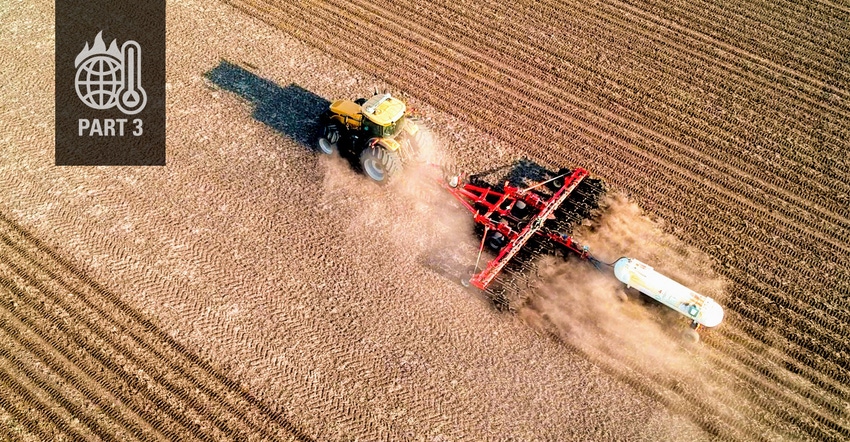
U.S. agriculture has made great strides to lower Greenhouse Gas (GHG) impact by producing more milk, meat and crops per unit, therefore shrinking its carbon footprint. According to Cargill the North American beef industry is already 35% more efficient, from a GHG perspective, than the global average (more on Cargill’s GHG goals here). The dairy folks already have a tech-savvy plan to make itself carbon neutral by 2050 (see more here).
But there’s more to do.
According to Farm Bureau, crop cultivation represents half of ag-related greenhouse gas emissions (see more here). We can cut that number with carbon-friendly practices like no-till, cover crops, green manures, waterways and buffers. Having something growing on every field year-round is a worthy goal.
One big offender – and life giver - is synthetic nitrogen fertilizer production, which hits the atmosphere twice: first in manufacturing where it requires fossil fuel energy, then again when some fertilizer inevitably escapes in the application process.
We can’t live without industrially-produced fertilizer, a $212 billion industry, but it is responsible for 3% of greenhouse gas. More than one percent of the world’s total energy production goes to produce nitrogen fertilizer. Developed countries contend with waterways polluted from leaching nitrogen, while adequate fertilizer is often inaccessible or too expensive for farmers in developing countries.
Raising organic matter unlocks soil’s potential to provide nutrients to crops, which in theory reduces your fertilizer bill. Soil health and regenerative agriculture improves land and organic matter, captures carbon and reduces fertilizer use, but we’re barely scratching the surface on adoption.
Now biotech companies are developing bacteria that allow corn plants to convert nitrogen in the soil and atmosphere into plant food. California-based PivotBio is marketing “Proven,” a microbe that improves yields and offers plants a more sustainable nitrogen supply. Another company, JoynBio, is working on an engineered microbe that enables cereal crops to convert nitrogen into usable form.
The goal of both companies is to reduce or even replace synthetic nitrogen use, making cereal crops more carbon-friendly.
“Everybody wants to find alternatives to synthetic chemical fertilizers,” says Joyn CEO Mike Miille. “The greenhouse gas to produce it, and environmental effects of runoffs, have gotten to the point where people are concerned. It’s not sustainable.”

Nitrogen-fixing corn?
Meanwhile researchers from University of California, University of Wisconsin and Mars, Inc., discovered a tropical corn in Oaxaca, Mexico that can acquire significant amounts of nitrogen from the air by cooperating with bacteria. The corn secretes mucus-like gel from aerial roots; the gel harbors bacteria that converts atmospheric air into a form usable by the plant.
Corn that can fix its own nitrogen, like soybeans or other legumes, would be agriculture’s holy grail.
That Mexican corn can acquire up to 80% of its nitrogen needs this way. But scientists are still a good 5 to 10 years away from breeding that trait into a useful hybrid for the northern hemisphere (full story here).
Until these technologies become common you can cut synthetic fertilizer by other means, including green manures from cover crops and side dressing with precision applications. Adopt regenerative ag practices.
The easiest move is simply fertilizing for maximum economic return, not just yield. Too many farmers apply more fertilizer than plants can use. Follow recommended guidelines and the climate, and your pocketbook, will thank you.
And of course, it takes fossil fuels to run tractors, trucks and combines. This is where dairy has a real head start by using digesters. They’re taking that renewable natural gas from capped lagoons and powering vehicles.
Oh yeah. Food.
Let’s be clear: humankind made a conscious decision to engineer the land to produce food. We introduced strategies around soil health, water and fertilizer, to make sure we have food security. We made a careful determination to scale up production methods so that most everyone could afford to eat and go on to become doctors, teachers, artists and plumbers.
This was not a difficult call. Mother Nature could rest easy if we decided at some point not to feed humans.
Even so, we must admit what we’re doing now is not perfect.
“We will get some nitrogen runoff even with our best practices,” says Eric Snodgrass, Nutrien atmospheric scientist and former director of undergrad studies for the department of atmospheric sciences at University of Illinois. “It’s not possible to keep every ounce of nitrogen in a field, and farming does consume a lot of energy in the form of fossil fuels.”
People forget to weigh the food security provided by production agriculture against its environmental impacts.
Coming in part four: Is carbon trading an answer?
Missed some content in this series?
Part one: Will farmers get paid to save the planet?
Part two: What’s at stake in the debate over climate change
Part three: Synthetic fertilizer is a modern miracle but it’s wrecking the atmosphere. Can we do better?
Part four: Is carbon trading an answer?
Part five: Are burping cows really a threat to humanity?
Part six: Farmers, tell your story
Read more about:
ClimateAbout the Author(s)
You May Also Like






